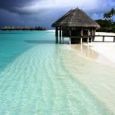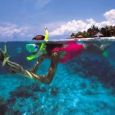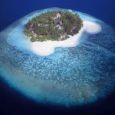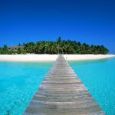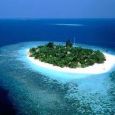Maldives
Advertisement
Getting there & away
Travel documents
Passport
There are no restrictions on foreign nationals entering the country. Israelis and people who have Israeli stamps in their passports are perfectly welcome, which is rare in the Muslim world. Visas are not needed for visits of 30 days or less. Theoretically travellers must have US$30 per day for the duration of their stay.
Tickets
If you’re on a package you’ll usually have no choice about the airline you fly, as it will be part of the package. Fully independent travellers (FITs) should shop around for both scheduled and charter deals. More and more chartered airlines are selling flight-only seats and these can be good deals. The other advantage of charter flights is that you can fly direct from Western Europe to Male’, without the usual change in the Middle East or Sri Lanka common for scheduled airlines.
Sea
Sri Lanka
Despite the obviousness of this route, it is currently impossible to travel between Sri Lanka and the Maldives by boat. There are no scheduled ferries operating, nor do cargo ships generally take paying passengers. You might be lucky if you ask around in Colombo, but we don’t recommend this.
Yacht
Yachts and super yachts cruise Maldivian waters throughout the year – this is after all one of many playgrounds for the rich and famous. However, with the Maldives being somewhat out of the way, this is not a standard port of call. The Maldives has not been a popular stop for cruising yachties, but more are coming through and official policy is becoming more welcoming. The negatives include: the maze of reefs that can make it a hazardous area; the high fees for cruising permits; the officialdom; the restrictions on where yachts can go; and the absence of lively little ports with cheap cafés and waterfront bars.
A new 100-berth marina has been built at Island Hideaway in the far north of the country, and this is the only place currently set up for servicing yachts in a professional way. Addu, in the far south, has a sheltered anchorage, a tourist resort and refuelling and resupply facilities.
The three points where a yacht can get an initial ‘clear in’ are Uligamu (Haa Alif) in the north, Hithadhoo/Gan (Addu Atoll) in the south, and Male’. Call in on VHF channel 16 to the National Security Service (NSS) Coastguard and follow the instructions. If you’re just passing through and want to stop only briefly, a 72-hour permit is usually easy to arrange. If you want to stay longer in Maldivian waters, or stop for provisions, you’ll have to do immigration, customs, port authority and quarantine checks, and get a cruising permit. This can be done at any of the three clear-in facilities.
If you want to stop at Male’, ensure you arrive well before dark, go to the east side of Viligili Island, between Viligili and Male’, and call the coastguard on channel 16. Officially, all boats require a pilot, but they don’t usually insist for boats under 30m. Carefully follow the coastguard’s instructions on where to anchor, or you may find yourself in water that’s very deep, or too shallow. Then contact one of the port agents, such as Island Sailors (3332536; www.islandsailors.com) or Century Star (3325353). A full list of agents can be found at www.customs.gov.mv/agents.htm.
Port agents can arrange for port authority, immigration, customs and quarantine checks, and advise on repairs, refuelling etc. They’ll charge about US$175 for a two-week stay, including all government charges – it would be a nightmare to do it all without an agent’s help. After the initial checks you’ll be able to cross to the lagoon beside Hulhumale’, the reclaimed land north of the airport. This is a good anchorage. The bigger stores, like STO People’s Choice and Fantasy, have quite a good range of provisions at reasonable prices. The port agents can advise on other necessities such as radio repairs, water and fuelling. Diesel fuel is about Rf5 per litre.
The cost of a cruising permit increases greatly with the length of stay – the first two weeks are free, the first month is US$200, and the second month US$300. Customs, port and inspection charges increase with the size of the boat. If you go cruising in the tourism zone, you’ll be able to stop at many of the resorts to eat, drink, swim, dive and spend your money, but you should always call the resort first. Usually you have to be off the island by sunset.
Before you leave Maldivian waters, don’t forget to ‘clear out’ at Uligamu, Hithadhoo or Male’.
Entering the destination
Entering the country
Entering the Maldives is simple and hassle-free. However, you must know the name of your resort or Male’ hotel, and if you are travelling independently and don’t have one arranged, then be prepared to make one up – the immigration officials will view anyone just arriving in the country with great suspicion.
Air
Airports & airlines
At the time of writing there was only one international airport in the Maldives – Male’ International Airport (MLE; 3322075; www.airports.com.mv), on the island of Hulhule’, 2km across the water from the capital. It’s a decent airport that was being upgraded to include new departure and arrival areas at the time of research. The current domestic terminal on the southern island of Gan is also being upgraded to a new international airport, and should be taking international charter flights some time in the near future.
There is no national carrier; the carriers serving Male’ can roughly be divided into scheduled and charter airlines. Some airlines only fly in certain seasons and the list of charter airlines changes frequently.
Addu Atoll
Definitely one of the best places for independent travellers to come, heart-shaped Addu Atoll is the most southern extreme of the country and has a very different feel to it for a number of reasons. It’s good for so-called FITs (fully independent travellers), as from Equator Village, the charming budget resort on the former British naval base of Gan, you can cycle to three inhabited islands via a causeway – the only resort in the country where you have such access and freedom.
Click here to find out more!
Advertisement
Addu Atoll is the main economic and administrative centre in the south of the country, and the only place to rival Male’ in size and importance. Its 28, 000 people spread out over seven inhabited islands is a huge number in the Maldives. With the airport being upgraded at the time of writing to accommodate long-haul flights and the huge, luxury Shangri-La resort being built on the nearby island of Viligili, the region will play an important role in the future development of the Maldives’ travel market.
There is an independent streak in the Addu folk – they even speak differently from the people of Male’. Tensions came to a head in the 1960s under the leadership of Abdulla Afif Didi, who was elected president of the ‘United Suvadiva Islands’, comprising Addu, Foammulah and Huvadhoo. Afif declared independence from the Maldives, but an armed fleet sent south by Prime Minister Ibrahim Nasir quashed the short-lived southern rebellion. Afif fled the country, but is still talked about on his home island of Hithadhoo. He went to live in the Seychelles, where he ultimately rose to the position of foreign minister.
The biggest influence on Addu’s modern history has been the British bases, first established on Gan during WWII as part of the Indian Ocean defences. In 1956, when the British could no longer use Sri Lanka, they developed a Royal Air Force base on Addu as a strategic Cold War outpost. The base had around 600 personnel permanently stationed here, with up to 3000 during periods of peak activity. The British built a series of causeways connecting Feydhoo, Maradhoo and Hithadhoo islands and employed most of the population on or around the base. In 1976 the British pulled out, leaving an airport, some large industrial buildings, barracks and a lot of unemployed people who spoke good English and had experience working for Westerners. When the tourism industry took off in the late 1970s, many of the men of Addu went to Male’ to seek work in resorts and tourist shops. They have never lost their head start in the tourism business and to this day, in resorts all over the country, there’s a better than even chance that the Maldivian staff will be from Addu.
Tourism development in Addu itself has been slow to start, due to bad transport links. Now there are several flights a day to Male’ and direct charter flights to Gan should be in operation from 2007.
Male’
A tiny island, densely crowded with motorbikes, bustling business people, stern-faced policemen, hawkers and crisply uniformed school children, Male’ (mar-lay) is the modern, mercantile face of the Maldives that few people take the time to see. Overlooked by brightly coloured tall thin buildings and surrounded by incongruously turquoise water all around, this is the centre of the Maldives, the engine driving its economic progress and the forum for the country’s (stifled) political debate.
Click here to find out more!
Far smaller than the neighbouring airport island of Hulhumale’ – where long-haul flights land on a runway that dwarfs the main avenues of the capital – Male’ nevertheless feels like an important place, where the economic, political and cultural leaders of the republic congregate, where nearly all the country’s massive number of exports arrive and where more than a few expats and travellers find themselves from time to time. That said, Male’ is interesting to visit mainly for a taste of Maldivian life more than for its inherent wealth of things to see and do. Independent travellers (or FITs as they are known locally) will find that this is a place they see a lot of – it’s also one of the few places where palm trees and sandy beaches aren’t on the menu.
Male’ is pleasant and pleasingly quirky – its alcohol-free bars and restaurants jostle with its incredible array of shops and lively markets (imagine that in this tiny space all imports into the country are administered and sold) and the general hubbub of a capital is very much present. This is a chance to get a real feel for the Maldives, what makes its people tick and to meet Maldivians on an equal footing.
Southern Atolls
All eyes are currently on the southern Maldives to provide the islands for the future development of tourism in the Maldives. The already-crowded central Maldives and the bad transport links to the northern atolls mean that the pristine south is, in the words of many a developer, ripe for it. There are three regional airports with daily connections to Male’ already here and the new international airport at Gan will begin taking long-haul flights from Europe and Asia, so tourism arrivals to this relatively untouched area of the country are set to dramatically increase.
Click here to find out more!
Advertisement
Until a few years ago, the atolls south of Male’ and Ari Atolls were isolated and had scarcely seen a foreigner. The exception was Gan, in the far south of the country, where the British had established military facilities in WWII and an air-force base that operated from 1956 to 1976. Even 30 years after the British departed Gan still has an unusually British feel.
Staying at the budget Equator Village remains one of the best ways to experience real life in the Maldives, as a new road has connected Gan to three other inhabited islands that tourists are free to explore by bicycle or taxi without the usual restrictions.
Development is set to be huge over the next decade here: the tourism zone looks set to be expanded to cover all five southern atolls that are currently off-limits to non-permit-holders, safari boats are regularly exploring dive sites as far south as the Huvadhoo Kandoo (famously known as One-and-a-Half-Degree channel), and surfing trips are going to the remotest breaks of Gaaf Dhaal. Despite this, the region is almost totally pristine and a wonderful place to visit.
Watersports
* Surfing
In a place that is more sea than land, there is no end to the fun things you do in the water. Maldivians swim for recreation, they play water polo with their friends at weekend picnics, they surf addictively. The visitor is not excepted: every single resort of the Maldives has a sports centre that provides a range of watersports activities.
These centres are well equipped with masks and snorkels and boards of varying sizes, whether you want to spend the day snorkeling and meeting glances with wide-eyed fish, or feeling the wind in your hair on a windsurfer or catamaran. Some centres offer courses for beginners and advances windsurfers and sailors. You could also chose to parasail, kayak, kite-surf, water-ski, and jet-ski.
Surfing
Maldives is a mecca to surf-enthusiasts from all over the world, with the southwest monsoon bringing with it massive swells, especially from June to September. The sizes range from 3 – 8 feet. There are several well-known surf breaks in North and South Male’ Atoll. Resorts near these breaks are perfect for surfing aficionados, as you can get the full Maldivian experience while riding the waves to your hearts content. The
lesser-known, but amazing surf breaks further away from Male’ atoll can be accessed by specialised surf cruises (often referred to as surfaries) offered by cruise operators in the country.
Things to Do
Diving Maldives
The warm seas of Maldives have high visibility throughout the year, with water clear enough to see the passing fish as far as fifty metres away at times. Add to that the marvellous formation of over 3000 coral reefs and the free flowing tides of the monsoons. The result of these perfect conditions have created one of the world’s richest diving coral reef areas.
Over a thousand species of fish and other underwater creatures inhabit the Maldivian waters. The monsoon tides of the Indian Ocean create a collection of small marine creatures as well as microscopic plant cells. This in turn creates a hub for all kinds of underwater species who gather in these waters lured by
the abundance of food. In the Maldives you will get to see everything. From tiny shrimp and groups of colourful swimmers to the magnificent mantas and sharks, a careful eye will give you enough to enrapture you for a lifetime.
The best thing is that you need not be a professional diver to enjoy the Maldives. All resorts and safari boats give you basic to advanced training using well-monitored diving facilities of a high standard. Even the most reluctant diver can enjoy the beauty of Maldivian underwater life on a drift dive with the guidance of experienced dive instructors. A dive in a house reef is equally rewarding, all you need to do is swim a few minutes from shore. Due to the countless number of reefs found among the 26 atolls in the Maldives, all you
need to do is travel 15 to 60 minutes by boat to get to a different dive spot every day.
Dives in the Maldives usually take place along a faru (reef), a thila (a submerged aquarium like reef, on a channel where the atoll meets the ocean, or on a wreck. Night diving is particularly beautiful as is a macro dive that lets you see tiny, interesting and usually disregarded creatures up close and personal.
Excursions
* Local islands
* Night fishing
* Virgin islands
The best way to experience the life of an ordinary Maldivian is to travel to an inhabited island.
Local islands
The best way to experience the life of an ordinary Maldivian is to travel to an inhabited island. Some of these islands are slightly more modern: with brightly painted house walls and harbour areas. There are also the quite fishing villages with lots of tree-shade, swings, and the traditional wooden holhuashi. A holhuashi is rather like an island-version of a gazebo, build with hollow wooden trunks tied together forming the large, bench-like seat, and often with a thatched roof. They are conveniently set up on beaches, often where the boats come in, and is a place where islanders wind off after a day’s work, exchanging news, telling stories, playing cards, and listening to local radio.
Fishing, agriculture, and fish related manufacturing is what most people in the islands do for work while some go away to find jobs in tourism and trading. Some islands are also good places to buy local handcrafts.
It is a typical island custom that everyone finish their work by late afternoon, take their daily showers or bath near their wells, dress the children in fresh clothes and go for a stroll in the island, visiting friends and relatives, delivering small bowls of fresh homemade curry, or taking some time to relax at the beachside, watching the late afternoon sun while the children play around at the beach.
Night fishing
Fishing is in the Maldivian blood. It is so entwined in the lives of Maldivians that there are celebrations when a good catch is caught, and complaints when fish is scarce at our dinner tables. Maldivian fishermen wake
up to the dawn call of island roosters, collect bait in nearby reefs and start a full day’s work at the deep blue seas, using the artful pole and line method of fishing.
To experience the satisfaction of catching and cooking your own fish, a night reef fishing trip (offered by a lot of resorts) is the way to go. Your boat leaves before the sunset to find a good spot near a reef. The boat crew will show you how to use the lines, hooks, and sinkers. You will catch enough to fill your barbecue grill in about an hour’s time.
Virgin islands
After a good catch it is time to head to a deserted island to eat and celebrate. With over 1,190 islands and only few hundred being utilised, it is easy to find an uninhabited island anywhere in the Maldives.
While the fish you caught gets grilled to perfection over red hot ambers, make sure you take time to enjoy the experience of being alive on this untouched part of nature; the softness of sand that has not seen a human foot print for a long, long time, and the undisturbed sounds made by nature. Without a single light on the ground, the stars above come alive in abundance, while tiny lights of phosphorescence get washed up by the beachside with the wave. For a moment, it is as though you are floating among the stars.
A day-time trip to a desert island is an experience of its own. The raw, unspoilt vegetation surrounded by blinding beaches and dazzling sunbeam-lined waters are like a phantasm; everything feels imagined, and you are the only person in this beautiful universe.
The Maldives Honeymoon
If a honeymoon is meant to be a celebration of love in an intimate,secluded, and most importantly, beautiful setting, then the Maldives is the world’s best backdrop for all these things. There are endless ways to let the magic of the islands dazzle you on your holiday as a couple. A dinner under the stars with the occasional flicker of candle light to bring you back into the real world, a daring getaway to a nearby uninhabited island all by yourselves for the whole day, or just lazing around in your private bungalow watching the endless turquoise waters while you are treated to an spa treatment in the room.
You could choose to get to know each other through a swim around a house reef with a mask and fin, or dive among the beautiful, vibrant reefs. It is an experience you will relive for days after you get back home. Indulge in some lighthearted competition on a night fishing trip by seeing who catches more. You will not forget the amazing boat trip you make at sunset before anchoring at a suitable fishing spot. It is as if nature plays with the colours of the setting sun just to ensure that you remember this day, this moment, and this love for the rest of
your life.
Your honeymoon need not be a once in a lifetime experience either. You will relive the honeymoon over and over again, every time you come back to
these magical islands.
Spa and wellness
Just lying on a deserted beach of a Maldivian island, taking in nothing but the continuous rhythm of the waves, the sea salt in the air and feeling the soft white sand on your bare feet is enough to sooth your senses. Each island with its green vegetation and secluded setting is a natural spa in its own right, designed
to soothe, caress, and heal.
Spas set in the Maldives, thus, are perfected as the ultimate getaway cocoons in the middle of the vast Indian Ocean. Traditional healing methods, that have been passed on for generations as family secrets by the hakeembe (healing experts), have been incorporated into special spa programs in the Maldivian islands.
The types of treatments vary with each spa but you can get almost any world-class treatment in a Maldivian spa. Every Maldivian resort has a spa; some of them nestled deep within thick vegetation, others sitting in solitude on a wooden jetty built on the lagoon, and some even built underwater.
Maldivian virgin coconut oil produced using age-old extraction techniques which is known among islanders for its hydrating and healthful elements is now used in some resort spas, as is the local favourite gandhakolhi leaf which is blended to treat almost any minor ache, and the traditional Maldivian sand massage used by islanders to cure muscle and joint pains.
Information not available


